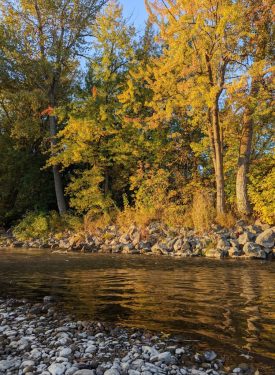A couple of Ada County applications (Master Site Plan Checklist and Preliminary Plat Checklist) require that a Natural Features Analysis (ACC 8-4E-4D) be completed as a part of the application. This page provides information and examples to walk applicants through our expectations and provide helpful resources for them to complete this element of their application.
Overview of Natural Features Analysis
A natural features analysis can be conducted either by a professional or by the applicant themselves. It is not mandatory for a licensed engineer, landscape architect, or other design professional to carry out this analysis.
Hydrology
Describe the water-related features on your property, such as streams, rivers, lakes, ponds, wetlands, and floodplains. Include any drainage ditches, culverts, irrigation canals, and ponds for managing water. Mention any irrigation systems and clearly show where these features are located in relation to your project.
Visit the FWS Wetlands Mapper for more information.
Soils
Describe the soil types on your property. Note any areas with soil erosion or contamination. Explain how water flows through or collects in different parts of the property, and how this might affect soil and plant growth. A detailed soil report from the Web Soil Survey is usually needed.
Visit the Web Soil Survey for more information.
Topography
Describe the land’s shape, including slopes, depressions, hills, valleys, plateaus, and dunes. A brief description may be enough, but detailed site contours might be required.

Vegetation
List the types of plants on the property. Include any invasive species and note any protected or endangered plants. Mention areas with dense trees and regions covered mainly by grass. Indicate where these plant types are located and any seasonal changes.
Sensitive Plant and Wildlife Species
List the species on the property, including migratory paths and breeding grounds. Describe the habitats like grasslands, forests, or wetlands. Include an IPaC report showing sensitive species and note how often you see them and when they are active.
Visit the IPaC for more information.

Historic Resources
Identify any historic features on your property, such as buildings from before 1970 or sites of historical or cultural importance. Check Ada County’s historic resources map for any listed resources and describe them if they are present.
Visit the Historic Resources Map for more information.
Hazardous Areas
Describe any dangerous areas on the property, such as flood zones, fire risks, chemical storage sites, abandoned structures, large potholes, or hazardous animals.
Impact on Natural Features
Explain how your development will affect the natural features mentioned above. If there will be impacts, describe how you will address them, including erosion control, water quality protection, wildlife preservation, and vegetation restoration.
Examples of a Natural Features Analysis and Supporting Documents
Natural Features Analysis Example
